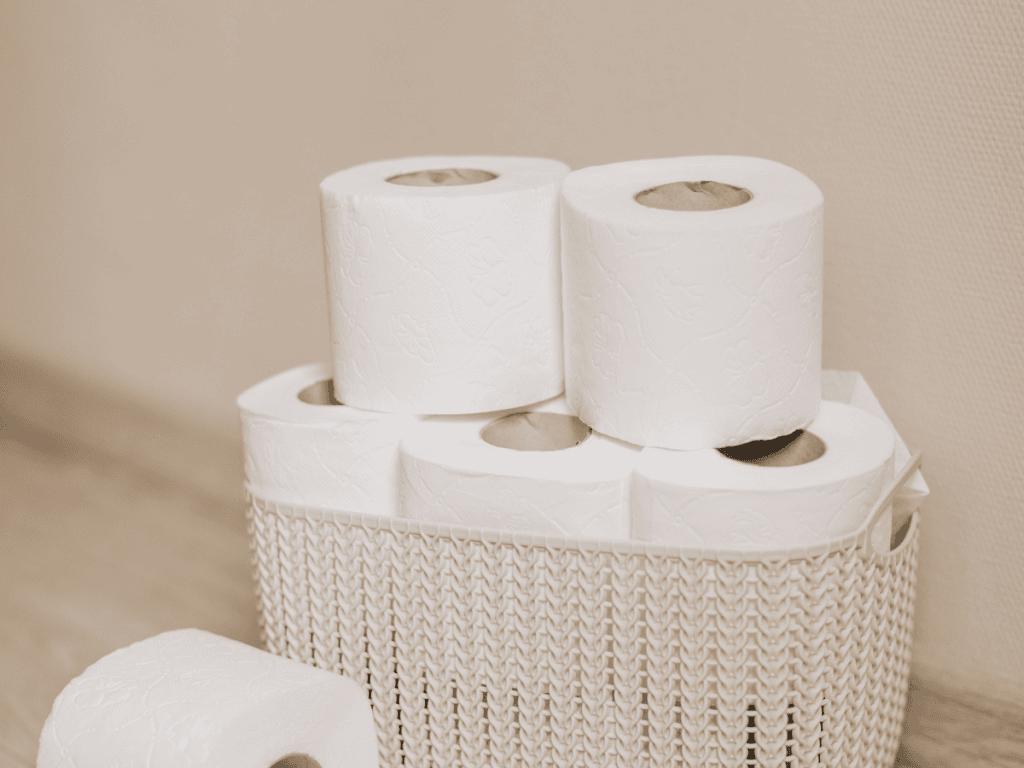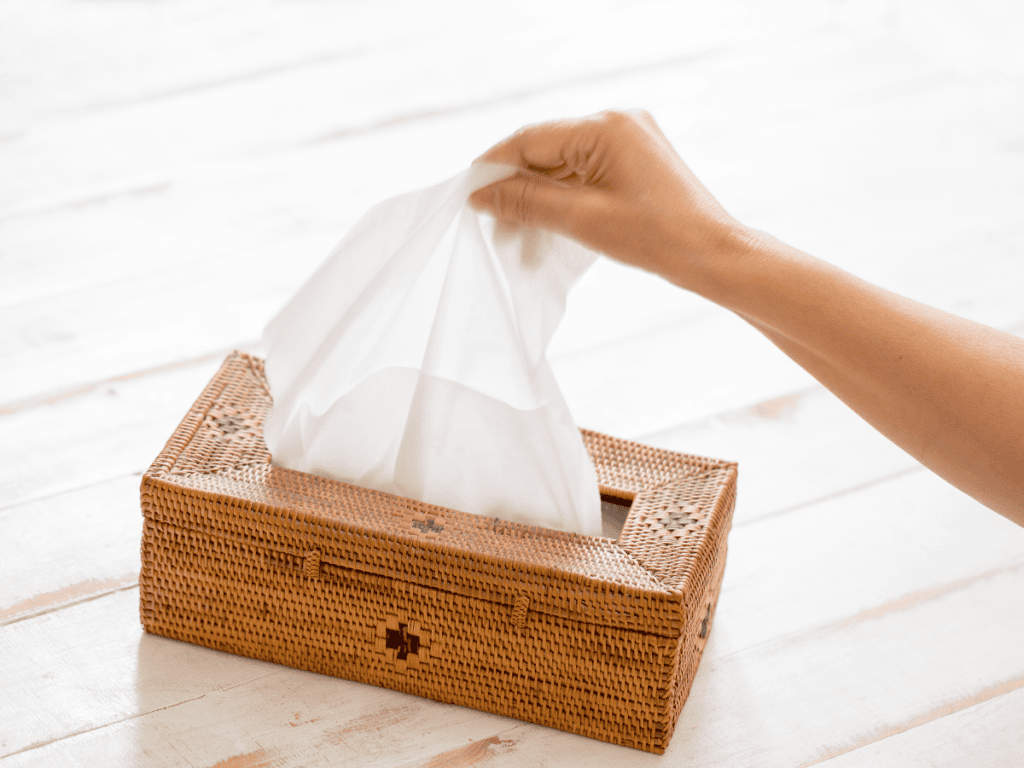Have you ever wondered what happens to that tissue paper you toss in the recycling bin after wiping your hands or blowing your nose? As someone who cares about the environment and tries to make sustainable choices, I pondered this question frequently. This article will delve into the intriguing world of is tissue paper recyclable.
As an environmentally conscious individual, I’ve often pondered whether the custom tissue paper that adds a special touch to gifts is recyclable or compostable. The good news is that there are sustainable ways to dispose of tissue paper, but it’s important to understand the specifics to make the right choice.
From my own experiences, I’ve realized that not all paper products are equal regarding recyclability. Tissue paper, often used for its convenience and disposability, presents a unique challenge in the recycling process. As I embarked on my journey to understand the fate of tissue paper post-use, I uncovered valuable insights that I’m excited to share with you.
The Basics of Tissue Paper Recycling
First and foremost, it’s essential to recognize that not all custom tissue paper is created equal regarding recycling. While many types can be recycled, the process can be complicated by ink, lamination, or the paper’s condition. The recyclability of tissue paper also hinges on local recycling program guidelines, which vary widely. As we explore the various aspects of tissue paper recycling, remember the importance of referring to local regulations.
Can Tissue Paper Be Recycled?
Indeed, some tissue papers are recyclable, provided they haven’t been contaminated with food, oil, or other materials that can hinder the recycling process. Pure, unsoiled tissue paper without embellishments can often be added to the recycling bin, but always check with local facilities as policies on tissue paper can differ.
The Impact of Inks and Dyes on Recyclability
When considering whether tissue paper can be recycled, the types of inks and dyes used are pivotal. Tissue papers printed with soy-based inks are generally more desirable in the recycling stream compared to those with traditional petroleum-based inks, as they break down more easily and are less toxic during the recycling process.
Acid-Free Tissue Paper: A Greener Choice
Opting for acid-free tissue paper is a proactive choice for those of us concerned about environmental sustainability. This type of paper is not only kinder to the items it protects, but it also has a reduced impact on the environment when recycled, as it doesn’t contain the chemicals that can degrade paper fibers during the recycling process.

Challenges in Recycling Tissue Paper
While the idea of recycling tissue paper is appealing, it’s not without its challenges. From the presence of additives to the quality of the paper itself, several factors can complicate the process, making it difficult for recycling centers to accept all types of tissue paper.
The Dilemma of Foil, Glitter, and Decorative Add-ons
The addition of foil and glitter makes for eye-catching tissue paper, but these materials are a nightmare for the recycling process. Foil and glitter, often containing microplastics, act as contaminants and can render a whole bin of recyclables destined for the landfill, as they cannot be separated easily during recycling.
Colored vs Plain Tissue Paper: Recycling Implications
Colored tissue paper, depending on the dyes used, can sometimes be more challenging to recycle than plain tissue paper. The dyes may affect the pulping process, leading to a lower quality of recycled paper, or may not be accepted by some recycling programs altogether due to potential contamination.
Why Used Tissues Are Not Recyclable
It’s important to understand that used tissues, like those for personal hygiene, are not recyclable. They are often contaminated with bodily fluids and can pose a health risk. Moreover, the fibers in these tissues are too short to be successfully processed into new paper products.
Alternative End-of-Life Options for Tissue Paper
When tissue paper cannot be recycled, environmentally friendly options are still available. Reuse and composting present viable alternatives to disposal, allowing us to extend the life of tissue paper or return it to the earth in a responsible manner.
Creative Reuse Ideas for Tissue Paper
For tissue paper that can’t make it into the recycling bin, there are plenty of creative reuse options. Repurposing tissue paper into new forms reduces waste and allows us to express our creativity. Let’s consider some imaginative ways to give new life to tissue paper.
Crafting Party Decorations
Tissue paper sheets, with their array of colors and lightweight nature, make for excellent materials in crafting unique party decorations. From pom-poms to streamers, the possibilities for reuse are plentiful, allowing for a sustainable approach to celebratory adornments.
Innovative Gift Wrapping Solutions
Transforming previously used tissue paper into innovative gift bags is a clever way to reuse this versatile material. Not only does this practice give a second life to tissue paper, but it also adds a personal touch to gift-giving, showcasing a commitment to sustainability.
Artistic Applications in Photography Backdrops
Photographers and creatives can repurpose tissue paper as vibrant backdrops or accents in their compositions. The translucency and texture of tissue paper can add depth and interest to photographic projects, all while adhering to environmentally conscious practices.
Composting Tissue Paper: A How-to Guide
Composting tissue paper is a natural end-of-life option, especially for those printed with water-based inks. These inks are non-toxic and break down readily in a composting environment, making tissue paper a suitable addition to your compost pile, provided it’s not metallic, glossy, or contaminated.
Determining the Compostability of Different Tissue Papers
When considering the end-of-life for tissue paper, compostability is a key factor. To determine if tissue paper can join the compost pile, I look for unbleached, dye-free, and unscented options, as these are more likely to break down effectively. While tissue paper is biodegradable, the presence of inks, perfumes, and lotions may hinder its ability to decompose. Therefore, I ensure that the tissue paper is as natural as possible before adding it to my compost to prevent contamination of the resulting humus.

Navigating Local Recycling Programs
Local recycling programs vary widely in what materials they accept for curbside recycling. In my experience, while tissue paper is recyclable, recycling facilities may not accept it due to the difficulty in sorting acceptable from contaminated tissue paper. Kraft paper, by contrast, is more uniformly accepted. To ensure I’m not mistakenly including non-recyclable tissue paper, I always check the specific rules of my local program. If tissue paper altogether is not accepted, I seek alternative sustainable disposal methods like composting or reuse.
Identifying Recyclable Tissue Paper Types
The quest to recycle tissue paper begins with identification. Not all types—such as paper towels and facial tissues—are suitable for recycling because they are often contaminated with oils, lotions, or other residues. In contrast, clean and dry tissue paper that has not been used for personal care can often be recycled. I consider tissue paper types that lack heavy dyes or fragrances, as these characteristics make the paper more likely to be accepted by recycling programs, given that tissue paper is biodegradable under the right conditions.
Curbside Recycling: Tissue Paper Rules and Regulations
Curbside recycling programs have specific rules for what can and cannot be recycled. In my area, while tissue paper can be recycled, curbside recycling is not always acceptable. These programs often have guidelines about the condition of the tissue paper; for example, it must be free of food, oil, glitter, and heavy dyes. To avoid contamination of the recycling stream, I pay close attention to these regulations and only include tissue paper that meets the criteria provided by my local waste management authority.
Drop-off Recycling Centers and Tissue Paper
Drop-off recycling centers can be a viable option for tissue paper that’s not accepted in curbside recycling programs. Before I take my tissue paper to a center, I confirm whether they accept it and under what conditions. Some centers have the capacity to process tissue papers that local curbside programs cannot handle, making them a convenient alternative. It’s always important for me to ensure that the tissue paper is clean and free from decorations before dropping it off to avoid contaminating the recycling process.
Best Practices for Reducing Tissue Paper Waste
Reducing tissue paper waste begins with mindful consumption and proper disposal. To minimize waste, I only purchase what I need and choose recycled or sustainably sourced tissue paper. Composting is an excellent way to repurpose food waste or lightly soiled tissue paper. By being aware of the waste hierarchy—reduce, reuse, recycle—I make choices that significantly decrease the amount of tissue paper waste I generate, which benefits the environment.
Embracing Reusable Alternatives to Tissue Paper
To further reduce tissue paper waste, I embrace reusable alternatives. Items like cloth napkins and handkerchiefs can replace disposable tissue paper for personal care. For packaging, I use materials like bubble wrap and packing peanuts that can be reused multiple times. These alternatives are not only recyclable and compostable, but they also cut down on the need for single-use tissue paper, helping to conserve resources and reduce waste over time.
Eco-Friendly Tissue Paper: What to Look For
When selecting tissue paper, I focus on eco-friendly attributes. Sustainable packaging and printed tissue that uses soy-based or water-based inks are on my checklist. I also consider whether the tissue paper is sourced from responsible paper mills and whether the product is part of a waste management program emphasizing recyclable packaging. These considerations help me make more environmentally conscious choices and support companies prioritizing sustainable practices.
Educating Others About Sustainable Tissue Paper Use
Sharing knowledge about sustainable tissue paper use is crucial for collective environmental progress. I take the opportunity to inform others about the benefits of using recycled tissue paper, the importance of proper disposal, and how to identify recyclable and compostable options. By spreading awareness, I hope to encourage more people to make choices that align with sustainability goals, ultimately reducing our ecological footprint and fostering a healthier planet.

The Future of Tissue Paper Sustainability – Is Tissue Paper Recyclable
The future of tissue paper sustainability looks promising as awareness grows and more people commit to eco-friendly practices. As I observe the industry, I see a shift towards greater transparency in production processes and increased availability of sustainable tissue paper products. This evolution suggests that we are moving in the right direction, with both consumers and manufacturers playing a role in reducing the environmental impact of tissue paper. The collective efforts to use tissue paper responsibly will undoubtedly contribute to a greener future.
Innovations in Tissue Paper Manufacturing
Innovation is key to advancing the sustainability of tissue paper. Manufacturers are exploring new technologies to reduce water and energy consumption during production. Additionally, there’s a growing trend towards sourcing alternative fibers, such as bamboo or recycled content, which can lessen the reliance on virgin wood pulp. These developments not only make the manufacturing process more eco-friendly but also set a standard for the industry to produce tissue paper that supports a more sustainable world.
The Role of Consumer Choices in Tissue Paper Recycling
As a consumer, I recognize that my choices significantly influence the recycling system’s effectiveness. When I select tissue papers made from wood pulp sourced from responsibly managed forests, I am supporting sustainable practices. Opting for products with high recycled material content also reduces the demand for virgin resources. Moreover, I understand that being diligent about separating tissue paper from paper and plastic contaminants in the recycling bin is crucial for ensuring that the recyclables are indeed processed. I contribute to a more efficient recycling loop by making informed purchases and proper disposal decisions.
How Retailers Can Promote Tissue Paper Recycling Awareness
Retailers have a unique opportunity to educate customers like me about sustainable disposal practices. They can encourage the recycling of cardboard boxes and tissue papers by providing clear instructions on what can be recycled and how to prepare materials for recycling. Retailers can also lead by example, using recyclable packaging and offering incentives for customers who bring their own or reuse materials. By actively promoting the importance of recycling, retailers can play a significant role in raising awareness and fostering a culture of sustainability among consumers.
The Environmental Significance of Tissue Paper Disposal Choices
My disposal choices for tissue paper carry significant environmental implications. When I choose to compost tissue paper, I help to reduce landfill waste and support the creation of nutrient-rich soil. On the other hand, incorrect disposal, such as sending non-recyclable or contaminated tissue papers to recycling facilities, can hinder the recycling process. It is imperative for me to understand the environmental impact of these choices to steer towards sustainable disposal and minimize my ecological footprint.
Encouraging a Shift Towards Sustainability in Everyday Products
Encouraging a shift towards sustainability in everyday products like tissue paper is vital. I support industries that innovate and produce greener options, recognizing their efforts during events like National Forest Products Week. Such occasions remind me of the importance of the forest products industry’s role in advancing a sustainable future. It reinforces my commitment to purchase products that align with sustainable practices and to advocate for environmentally responsible product development.

The Collective Impact of Proper Tissue Paper Recycling Practices
The collective impact of proper tissue paper recycling practices is undeniable. When I, along with my community, diligently recycle and compost tissue paper, we contribute to reducing waste and conserving resources. The cumulative effect of our actions can lead to significant environmental benefits, including decreased deforestation and lower greenhouse gas emissions. By working together, we can ensure that our individual efforts are magnified, leading to a substantial positive change in our ecosystem.
FAQs
I’ve noticed that many people have questions about responsibly disposing of tissue paper. The answers can vary whether it’s about the ability to recycle tissue paper or the specifics of a local recycling program’s guidelines. It’s crucial to understand the nuances of recycling and composting tissue paper to make informed decisions on its disposal. Therefore, I recommend contacting local waste management services for the most accurate and up-to-date information regarding recycling programs and the sustainability of tissue paper products.
1. Is biodegradable tissue paper a better option?
2. How to responsibly dispose of non-recyclable tissue paper
3. Can you recycle tissue paper gift bags?
Final Thoughts on Tissue Paper Recyclability
In conclusion, tissue paper’s recyclability hinges on various factors, including consumer behavior, industry practices, and local recycling capabilities. While not all tissue papers are recyclable, especially those soiled or containing additives, the move towards eco-friendly options is gaining momentum. As a consumer, I recognize that my disposal choices combined with retailer education efforts can greatly improve tissue paper’s life cycle sustainability. Embracing a responsible consumption and disposal mindset is paramount for a greener future.